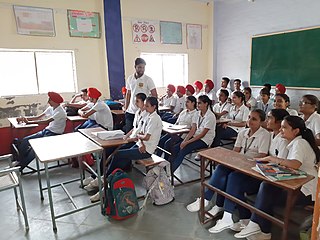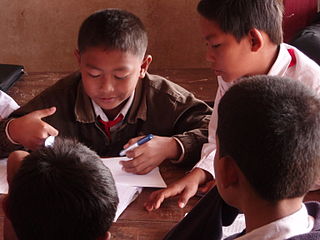
A boarding school is a school where pupils live within premises while being given formal instruction. The word "boarding" is used in the sense of "room and board", i.e. lodging and meals. They have existed for many centuries, and now extend across many countries. Their functioning, codes of conduct, and ethos vary greatly. Children in boarding schools study and live during the school year with their fellow students and possibly teachers or administrators. Some boarding schools also have day students who attend the institution during the day and return home in the evenings.

Education in India is primarily managed by the state-run public education system, which falls under the command of the government at three levels: central, state and local. Under various articles of the Indian Constitution and the Right of Children to Free and Compulsory Education Act, 2009, free and compulsory education is provided as a fundamental right to children aged 6 to 14. The approximate ratio of the total number of public schools to private schools in India is 10:3.

Education in China is primarily managed by the state-run public education system, which falls under the Ministry of Education. All citizens must attend school for a minimum of nine years, known as nine-year compulsory education, which is funded by the government.

A state school, public school, or government school is a primary or secondary school that educates all students without charge. They are funded in whole or in part by taxation and operated by the government of the state. State-funded schools are global with each country showcasing distinct structures and curricula. Government-funded education spans from primary to secondary levels, covering ages 4 to 18. Alternatives to this system include homeschooling, private schools, charter schools, and other educational options.

A private school is a school not administered or funded by the government, unlike a public school. Private schools are schools that are not dependent upon national or local government to finance their financial endowment. Unless privately owned they typically have a board of governors and have a system of governance that ensures their independent operation.

Education in Indonesia falls under the responsibility of the Ministry of Primary and Secondary Education, Ministry of Higher Education, Science, and Technology, and the Ministry of Religious Affairs. In Indonesia, all citizens must undertake twelve years of compulsory education which consists of six years at elementary level and three each at middle and high school levels. Islamic, Christian, Hinduism, Buddhist and Confucianism schools are under the responsibility of the Ministry of Religious Affairs.

The system of education in Uganda has a structure of 7 years of primary education, 6 years of secondary education, and 3 to 5 years of post-secondary education. Education in Uganda is administered in English. All throughout the levels in the education structure, modules are taught and assessed in English. The government of Uganda recognizes education as a basic human right and continues to strive to provide free primary education to all children in the country. However, issues with funding, teacher training, rural populations, and inadequate facilities continue to hinder the progress of educational development in Uganda. Girls in Uganda are disproportionately discriminated against in terms of education; they face harsher barriers when trying to gain an education and it has left the female population disenfranchised, despite government efforts to close the gap.

The International School of Penang (Uplands), commonly known as Uplands School or simply Uplands, is a boarding FOBISIA-member school in Penang, Malaysia. Founded in 1955, it was first situated on Penang Hill, moving to Gurney Drive and finally Batu Ferringhi in 2006. Uplands School is a multicultural, multiracial and multinational community whose aim is to promote the School Motto: "Respect for Self. Respect for Others".

Education structure in Tanzania is provided by both the public and private sectors, starting with pre-primary education, followed by primary, secondary ordinary, secondary advanced, and ideally, university level education. Free and accessible education is a human right in Tanzania. The Tanzanian government began to emphasize the importance of education shortly after its independence in 1961. Curriculum is standardized by level, and it is the basis for the national examinations. Achievement levels are important, yet there are various causes of children not receiving the education that they need, including the need to help families with work, poor accessibility, and a variety of learning disabilities. While there is a lack of resources for special needs education, Tanzania has committed to inclusive education and attention on disadvantaged learners, as pointed out in the 2006 Education Sector Review AIDE-MEMORE. The government's National Strategy for Growth and Reduction of Poverty in 2005 heavily emphasized on education and literacy.
Sacred Heart College is a Roman Catholic secondary school for girls, and is located in Retreat Road, Newtown, Geelong, Victoria in Australia. It is now one of the largest Catholic secondary girls schools in Victoria.
Internal migration in the People's Republic of China is one of the most extensive in the world according to the International Labour Organization. This is because migrants in China are commonly members of a floating population, which refers primarily to migrants in China without local household registration status through the Chinese Hukou system. In general, rural-urban migrants are most excluded from local educational resources, citywide social welfare programs and many jobs because of their lack of hukou status. Migrant workers are not necessarily rural workers; they can simply be people living in urban areas with rural household registration.

In 2005, the literacy rate in Laos was estimated to be 73%.

The Haitian Educational System yields the lowest total rate in the education realm of the Western Hemisphere. Haiti's literacy rate of about 61% is below the 90% average literacy rate for Latin American and Caribbean countries. The country faces shortages in educational supplies and qualified teachers. The rural population is less educated than the urban. The 2010 Haiti earthquake exacerbated the already constrained parameters on Haiti's educational system by destroying infrastructure and displacing 50–90% of the students, depending on locale.
Stanborough School is a coeducational independent day and boarding school in Watford, Hertfordshire, England. Situated in 40 acres of parkland in the village of Garston, it was founded by the Seventh-day Adventist church and remains under the governance of the church. It is a member of the Independent Schools Association.

In China, "left-behind children", also called "stay-at-home children", are children who remain in rural regions of the country while their parents leave to work in urban areas. In many cases, these children are taken care of by their extended families, usually by grandparents or family friends, who remain in the rural regions.

Education in Beijing includes information about primary and secondary schools in Beijing.
Women's education in Pakistan is a fundamental right of every female citizen, according to article thirty-seven of the Constitution of Pakistan, but gender discrepancies still exist in the educational sector. According to the 2011 Human Development Report of the United Nations Development Program, approximately twice as many males as females receive a secondary education in Pakistan, and public expenditures on education amount to only 2.7% of the GDP of the country. The unemployment rate of female graduates in Pakistan is approximately 3.8 times higher than that of their male counterparts.
Education inequality in China exists on multiple levels, with significant disparities occurring along gender, geographical, and ethnic divides. More specifically, disparities exist in the distribution of educational resources nationwide, as well as the availability of education on levels, ranging from basic to higher education.
Youth in Rwanda constituted 40% of the resident population in 2012, numbering 4.1 million. The Republic of Rwanda's Ministry of Youth, Culture, and Sports defines youth as those from age 14 to 35 years. Like many developing countries, Rwanda's population as a whole is quite young. Over 50% of the Rwandan population is under 20 years old and the median age of the population is 22.7 years old. Urban areas of Rwanda have a higher percentage of youth than rural areas, though 80% of young people in Rwanda live in rural areas. Youth constitute over 53% of the population within the capital, Kigali. The youth population in Rwanda grew by 30% from 2002 to 2012.
Scott Douglas Rozelle is an American development economist currently serving as a researcher at the Freeman Spogli Institute for International Studies and one of the co-directors of the Rural Education Action Program (REAP) at Stanford University. As of the late 2010s, Rozelle has spent over 30 years doing research heavily based on the agriculture, economics, and education of mainland China.












